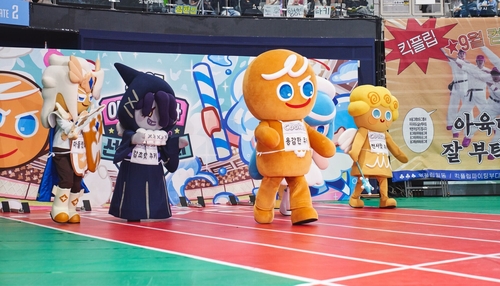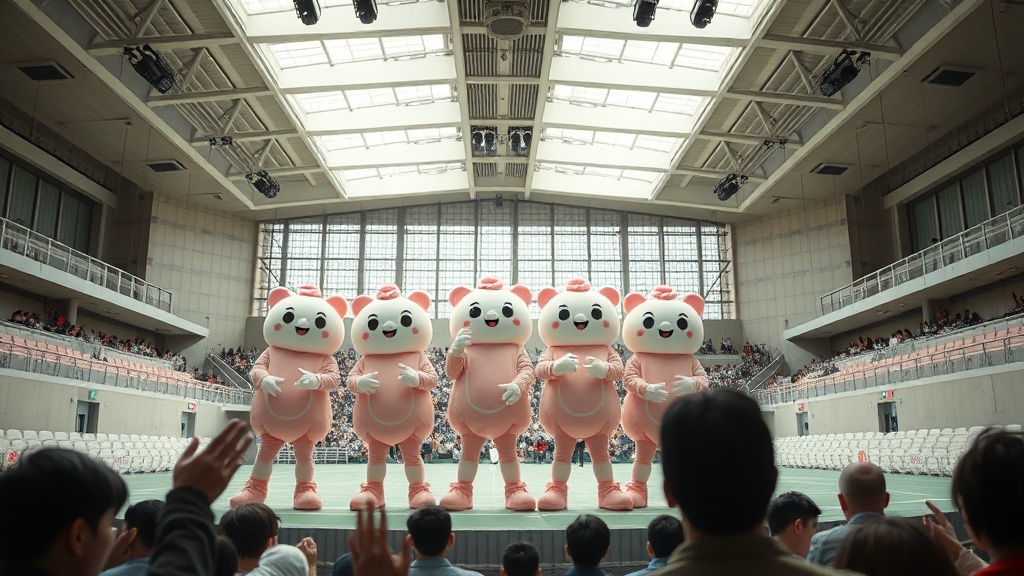On October 6, 2025, characters from Devsisters’ popular mobile game Cookie Run appeared on MBC’s Chuseok (Korean harvest festival) special of the Idol Star Athletics Championships (often called "ISAC").
On the broadcast, six characters—Brave Cookie, Strawberry Cookie, Angel Cookie, Madeleine Cookie, Licorice Cookie, and Cream Soda Cookie—performed a version of the national calisthenics routine and a K-pop medley, drawing quick attention from viewers.
The crossover highlights a clear aim to mix a game intellectual property (IP) with idol culture to expand fandoms and the brand.
However, the same staging also sparked debate over whether this kind of placement fits the spirit of variety programming.
Why did Cookie Run take the stage as idols?
Brief summary of the event.
Cookie Run showed up on TV.
The October 6, 2025 broadcast of MBC’s Chuseok special of the Idol Star Athletics Championships announced that Devsisters’ Cookie Run IP would appear in a K-pop idol concept under the group name "COOKIEZ."
The six characters on stage were Brave Cookie, Strawberry Cookie, Angel Cookie, Madeleine Cookie, Licorice Cookie, and Cream Soda Cookie. They performed a playful take on South Korea’s national calisthenics routine and a medley of K-pop dances, and at one point shared a stage with Hyungjun from CRAVITY for a joint number.
Putting a game character on a live TV stage is both an IP-expansion move and a way for broadcasters to refresh a longstanding show.
An experimental step like staging game characters on a variety show pushes the boundaries of popular culture. However, ISAC has long been a holiday special centered on idol camaraderie and friendly athletic competition, and this appearance arrived as the program sought fresh ideas for its 15th anniversary. In the broader context where broadcasters and game companies increasingly connect IP to offline events and TV content, Cookie Run’s appearance can be seen as part of a predictable trend.
Why now, and why ISAC?
Timing as a strategic choice.
The moment was deliberate.
ISAC’s holiday broadcasts attract high viewership and conversation, making them an ideal platform to maximize brand exposure. Devsisters has long expanded Cookie Run across age groups, so finding touchpoints that reach not only gamers but also families and K-pop fans mattered.
Consequently, the company used ISAC’s broad audience to launch the "COOKIEZ" concept and secure large-scale visibility.
Expanding an IP through mainstream TV remains an important route to connect online and offline fandoms.
In short, the move was more than advertising; it was an attempt to expand the IP experience. Meanwhile, ISAC’s 15th anniversary required novelty, and producers wanted to vary the show’s familiar format. Thus, programming needs and corporate marketing aligned to produce this collaboration.
Supporters: a chance for fandom crossover and cultural fusion
Positive aspects compressed.
It can enable fandom exchange.
Cookie Run’s appearance created a meeting point between game fans and K-pop fans. When both groups watch the same stage and talk about the same moments, they form shared topics and conversations. Consequently, this cross-pollination can increase engagement, broaden activity in each community, and drive participation on social platforms.
When games and music combine, new entertainment formats can emerge.
The example matters as a case of content fusion.
Since its 2013 debut, Cookie Run has steadily built its IP, and this TV appearance shows that game characters can collaborate with real entertainers on broadcast stages. Therefore, mobile titles are not confined to app screens but can become part of live performance and televised content.
The brand may also gain value.
Exposure on a mainstream program can make the game and its characters feel more approachable. Moreover, reaching families as well as younger viewers can boost long-term retention and new-user interest for the game.
From a marketing angle, this type of collaboration can produce high buzz with relatively modest cost.
Compared with traditional ads, an in-program appearance reduces resistance and encourages organic sharing on social media. So the short-term spike in attention can potentially translate into a longer-term brand asset.
Ultimately, Cookie Run’s appearance can lower barriers between fan communities and promote cultural fusion.
Opposition: worries about commercialization and mission drift
Presenting the critical point of view first.
The program’s original purpose can be threatened.
ISAC was built around idols’ camaraderie and athletic contests that let fans see their favorites compete informally. Packing the show with external characters risks diluting the competition’s reality and competitive drama. Some viewers may view the staging as excessive commercialization and voice complaints.
If variety shows become dominated by marketing, they can lose viewers’ trust.
There is also potential for fandom conflict.
K-pop fans prioritize live performances and team spirit, while game fans focus on characters and the game world. When those priorities clash, the viewing experience can fragment and some fans may feel their expectations were ignored. Excessive marketing can create feelings of betrayal or fatigue among longtime supporters.
Content focus can suffer too.
If audiences pay more attention to gimmicks than the competitions, the event’s athletic and entertainment value may fade. Over time, this could blur the show’s identity, so broadcasters must avoid chasing short-term buzz at the expense of core values.
Finally, the degree of commercial exposure must be watched carefully.
IP tie-ins can boost advertising effect, but if viewers perceive the appearance as overt promotion, the reaction may backfire. In other words, when the line between organic content and direct product placement is unclear, audience pushback grows.
For these reasons, both broadcasters and companies should weigh commercial aims against entertainment value.
Deeper analysis: motives and online reaction
Clarifying the causes.
This was a strategic decision.
Devsisters likely treated the ISAC appearance as an extension of a broader IP-expansion strategy. Diversifying revenue and raising brand recognition are necessary in the hypercompetitive mobile market. To grow globally while deepening local loyalty, companies need touchpoints beyond screens—on-stage appearances and TV broadcasts are two such touchpoints.
From the broadcaster’s side, creating a distinct 15th-anniversary program mattered.
Online reaction was mixed but leaned positive.
On social platforms and forums, many praised the characters’ cute entrance and the novelty of a game–idol collaboration. Clips and memes spread quickly, driving views and conversation. However, there were also voices arguing the show’s essence was compromised. Thus, enthusiasm was not unanimous.
Such ambivalence is normal in today’s media environment.
Audiences can both embrace new formats and expect familiar formats to retain their core values. Therefore, to sustain support, broadcasters and companies must actively manage fan expectations and pursue creative experiments without eroding the program’s identity.

Balancing pros and cons: what should be chosen?
Principles for finding balance.
Balance is essential.
Considering both sides, the key is moderation. Producers should preserve the creative gains of content fusion and the marketing benefits while protecting the show’s core values. Practically, this means transparency about why a character appears, balanced editing, and clear communication with viewers about what to expect.
Transparent collaboration and respect for viewers build long-term trust.
Rather than chasing short-term headlines, broadcasters should test new ideas in ways that keep the program’s identity intact. Companies, meanwhile, should seek ways to showcase their IP without alienating audiences. For example, clarifying the purpose of the Cookie Run segment or editing to honor both game and idol fans could reduce friction.

Recommendations: a blueprint for future collaborations
Concise implementation steps.
Clear guidelines are needed.
First, disclose the collaboration’s goals and expected effects to viewers and fans. Second, create editorial standards that protect the program’s identity during editing and staging. Third, design communication channels to ease possible conflicts between fan groups.
Policy design can convert short-term success into long-term trust.
These steps are not just for one broadcaster or one company. The entire content ecosystem should respect diverse fandoms and consumer expectations while developing sustainable collaboration models. That way, the cultural industries can build a stronger foundation for growth.
Conclusion: what did it leave behind?
Summing up the core points.
Cookie Run’s ISAC appearance demonstrated the potential for cultural fusion.
On the positive side, it fostered fandom exchange and brand expansion, marking a meaningful experiment for both the game maker and the broadcaster. On the other hand, it raised concerns about over-commercialization and dilution of the program’s purpose, signaling the need for careful handling.
Therefore, future collaborations should be built on transparency, balance, and respect for fan communities.
In short, the case confirmed the potential of a new format. However, to move beyond one-off hype and build long-term trust, clear guidelines and communication strategies are essential. Small, consistent actions that align stakeholders’ expectations will create lasting credibility.
Creative experimentation and responsible execution must coexist for cultural fusion to be sustainable.
What do you think: how far should a game IP be allowed to integrate with TV entertainment?